Thoroughly analyzing AP Inter 2nd Year Zoology Model Papers Set 8 helps students identify their strengths and weaknesses.
AP Inter 2nd Year Zoology Model Paper Set 8 with Solutions
Time: 3 Hours
Maximum Marks: 60
General Instructions:
Note : Read the following instructions carefully.
- Answer all questions of Section – A. Answer ANY SIX questions in Section – B and answer ANY TWO questions in Section – C.
- In Section – A questions from SI. Nos. 1 to 10 are of Very Short Answer Type. Each question carries TWO marks. Every answer may be limited to 5 lines. Answer all these questions at one place in the same order.
- In Section – B, questions from SI. Nos. 11 to 18 are of Short Answer Type. Each question carries FOUR marks. Every answer may be limited to 20 lines.
- In Section – C, questions from SI. Nos. 19 to 21 are of Long Answer Type. Each question carries EIGHT marks. Every answer may be limited to 60 lines.
- Draw labelled diagrams wherever necessary in Sections – B and C.
Section – A (10 × 2 = 20)
Note : Answer ALL the questions.
Question 1.
What is meant by double circulation ? What is its significance ?
Answer:
In this type of circulation blood circulate twice (2 times) through heart to complete circuit. There are two circuits.
- lesser circulation i.e., pulmonary circulation
- Greater circulation i.e., systemic circulation. Oxygenated and deoxygenated blood never mix.
Question 2.
Name the gland that increases in size during childhood and decreases in size during adulthood. What important role does it play in case of infection ?
Answer:
Thymus gland increases in size during childhood and decreases in size during adulthood. The secretion is thymosin plays a major role in the differentiation of T – Lymphocytes, which provide cell mediated immunity. It also promote production of antibodies.
Question 3.
Explain the mechanism of vaccination or immunization.
Answer:
The principle of vaccination or immunization is based on the property of the memory of the immune system. During vaccination, inactivated pathogens or antigenic proteins of pathogen are introduced into the body of host. They initiate the production of appropriate antibodies in the host and also generate memory B cells and memory T cells.
![]()
Question 4.
What is implantation with reference to embryo ?
Answer:
Attachment of blastocyst to the uterine mucosa till the whole of it comes to lie with in the thickness of the endometrium. This is called interstitial implantation. In human the implantation begins on the 6th day after fertilisation.
Question 5.
What are the four extra embryonic membranes ?
Answer:
The four extra embryonic membranes are Amnion, Chorion, Allantois and Yolk Sac.
Question 6.
What is amniocentesis ? Name any two disorders that can be detected by amniocentesis.
Answer:
Amniocentesis is a diagnostic procedure to detect genetic defects in the unborn baby. The most common abnormalities that can be detected by amniocentesis are Down syndrome, Edward syndrome and Turner’s syndrome.
Question 7.
What is meant by genetic load ? Give an example.
Answer:
The existence of deleterious genes with in populations is called genetic load.
Eg : Gene for sickle cell anaemia (homozygous individuals for sickle cell gene (HbSHbS) usually die early due to anemia. Those heterozygous (HbA + HbS)can live reasonably healthy and exhibit resistance to Malaria. So this disadvantageous gene is carried.
Question 8.
Define atavism with an example.
Answer:
Sudden appearance of some vestigial organs in a better developed condition as in the case of the tailed human baby is called atavism.
Question 9.
Define the terms layer and broiler.
Answer:
a) The birds which are raised exclusively for the production of eggs are called layers.
b) The birds which are raised only for their meat are called Broilers.
Question 10.
MRI scan is harmless – Justify.
Answer:
MRI scan is harmless because MRI does not use ionizing radiation as involved in X – rays and is generally a very safe procedure.
![]()
Section – B (6 × 4 = 24)
Note : Answer ANY SIX questions.
Question 11.
Draw a labelled diagram of the L.5. of the heart of man.
Answer:

Question 12.
Describe the intern al structure of kidney of man.
Answer:
Internal structure of Kidney : A longitudinal section of the human kidney shows two distinct regions, the outer cortex and the inner medulla. The medulla is divided into multiple cone shaped masses of tissue called renal pyramids. The renal pyramids are separated by the projections of the cortex called columns of Bertin (renal column). The base of each pyramid originates at the border between the cortex and the medulla and terminates in the renal papilla. Renal papillae project into cup like calyces, formed by the funnel shaped pelvis, which continues out as the ureter.
Question 13.
Write a note on Addison’s disease and Cushing’s syndrome.
Answer:
Addison’s disease is caused due to hyposecretion of glucocorticoids by the adrenal cortex. This disease is characterised by loss of weight, muscle weakness, fatigue and reduced blood pressure.
Sometimes darkening of the skin in both exposed and nonexposed parts of the body occurs in this disorder. This disorder does not allow an individual to respond to stress.
Cushing’s syndrome : It results due to over production of glucocorticoids. This condition is characterized by breakdown of muscle proteins and redistribution of body fat resulting in spindly arms and legs accompanied by a round moon face, buffalo hump on the back and pendulous abdomen. Wound healing is poor. The elevated level of cortisols causes hyperglycemia, over deposition of glycogen in liver and rapid gain of weight.
Question 14.
Describe the microscopic structure of testis of man.
Answer:
Each testis is enclosed in a fibrous envelope the tunica albuginea which extends inward to form septa that partition the testis into lobules. There are about 250 testicular lobules in each testis. Each lobule contains 1 – 3 highly coiled seminiferous tubules. A pouch of serous membrane (peritoneal layer) called tunica vaginalis covers the testis.

Each seminiferous tubule is lined by the germinal epithelium which consists of undifferentiated male germ cells called spermatogonial mother cells and it also bears ‘nourishing cells’ called Sertoli cells. The spermatogonia produce the primar spermatocytes which undergo meiotic division, finally leading to the formation of spermatozoa or sperms (spermatogenesis). Sertoli cells provide nutrition to the spermatozoa and also produce a hormone called inhibin, which inhibits the secretion of FSH.
The regions outside the seminiferous tubules, called interstitial spaces, contain interstitial cells of Leydig or leydig cells. Leydig cells produce androgens, the most important of which is testosterone. Testosterone controls the development of secondary sexual characters and spermatogenesis. Other immunologicafly competent cells are also present. The seminiferous tubules open into the vasa efferentia through the rete testis (a network of tubules in of the testis carrying spermatozoa from the seminiferous tubules to the vasa efferentia).
![]()
Question 15.
Suggest some methods to assist infertile couples to have children.
Answer:
Infertility is biological inability of a person to contribute to conception. A large number of couples in the conceivable age all over the world is childless. Infertility clinics and specialized health care units could help in diagnosis and corrective treatment of some of these disorders and enable the couples to have children. Assisted Reproductive Technology (ART) offers a wide range of techniques listed below can help the childless couple.
They are
- In vitro Fertilization and Embryo Transfer (IVF – ET)
- Zygote Intrafallopian Transfer (ZIFT)
- Gamete intrafallopian Transfer (GIFT)
- Intracytoplasmic sperm injection (ICSI)
- Artificial insemination (Al).
Question 16.
Describe female heterogamety.
Answer:
Female Heterogamety : In this method of sex determination, the males produce ‘similar gametes’ while females produce ‘dissimilar gametes’. Female heterogamety is of two kinds, ZO – ZZ type and ZW – ZZ type.
i) ZO – ZZ type : In moths and some butterflies, female is hetero-gametic with one z – chromosome (ZO) and male is homogametic with two Z – chromosomes (ZZ). The karyotype of female is AAZO and male is AAZZ. Females produce two kindsof ova, half of them with a Z – chromosome and the other half with no sex chromosome. Males produce . similartype of sperms. The sex of the offspring depends on the type of ovum that is fertilized.
ZW – ZZ type : In birds, reptiles, some fishes, etc., the females are hetero-gametic with ZW – allosomes and males are homogametic with ZZ – allosomes. The karyotype of the female is AAZW and that of the male is AAZZ. All sperms are similar with Sex determination in fowl the allosome – Z.
Ova are of two different kinds; one half of the ova are with the allosome – Z and the other half with the allosome – W. The sex of the offspring depends on the type of ovum that is fertilized.

Question 17.
Explain Hardy – Weinberg equilibrium.
Answer:
Hardy – Weinberg equilibrium was explained independently by Hardy of U.K. and Weinberg of Germany. It is a principle stating that the allelic frequencies in a population will remain constant from generation to generation under certain conditions.
They are :
- Size of the population should be large.
- Mating should be random (panmictic).
- There should no evolutionary forces like Natural Selection or mutations or large scale migrations.
- There should be no differential reproductive success, among the organisms of a population.
- All the members of a population should be homogenous in age.
Significance of Hardy – Weinberg equilibrium : Any deviation from one or more of these conditions will disturb the equilibrium by changing allelic frequency or genotypic frequency or both. These changes in frequncies are significant in producing variations, 1 which are the raw materials for evolution.
![]()
Question 18.
Explain in brief structure of Insulin.
Answer:
Structure of insulin : Human insulin is made up of 51 amino acids arranged in two polypeptide chains – chain A (21 amino acids) and chain B (30 amino acids), which are linked together by disulphide linkages. In mammals, including humans, insulin is synthesised as a pro- hormone (like a pro-enzyme, which needs to be processed before it becomes fully mature and functional hormone) which contains an extra stretch called the c peptide. This c peptide is not present in the mature insulin and is removed during maturation into insulin.
The main challenge for the production of insulin in the laboratory using rDNA technique was getting insulin assembled into its mature form.
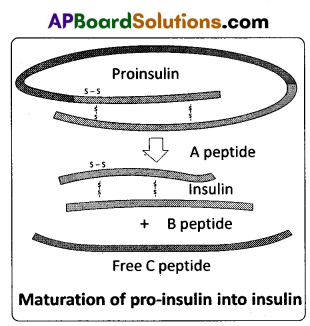
Section – C (2 × 8 = 16)
Note : Answer ANY TWO of the following questions.
Question 19.
Describe the physiology of digestion of various types of food in the human digestive system.
Answer:
Physiology of digestion :
Digestion is the process of conversion of complex non – diffusible food substances into simple diffusible forms. The process of digestion is accomplished by mechanical (cutting and chewing of food by teeth and churning of food by peristalsis) and chemical (enzymatic reactions by hydrolysing enzymes) processes.

i) Digestion in the buctal cavity : Buccal cavity performs two major functions, mastication of food and facilitation of swallowing (deglutition). Teeth and tongue with the help of saliva masticate and mix up Ihe food thoroughly. Mucus in saliva helps in lubricating and adhering the masticated food particles into a bolus. The saliva secreted into oral cavity contains electrolytes such as Na+, K+, Cl–, HCO3– and enzymes, such as salivary amylase (ptyalin) and lysozyme. The chemical process of digestion is initiated in the oral cavity (buccal cavity) by the hydrolytic action of carbohydrate (starch) splitting enzyme, the salivary amylase. About 30% of starch is hydrolyzed here into a disaccharide called maltose by the enzyme ptyalin. Lysozyme present in the saliva acts as an antibacterial agent that prevents infections.
ii) Digestion in the stomach : The stomach stores food for 4 – 5 hours. The food is mixed thoroughly with the acidic gastric juice of the stomach by the churning movements of its muscular wall and the product is called chyme. The mucus and bicarbonates present in the gastric juice play an important role in the lubrication and protection of the mucosal epithelium from ‘excoriation’ by the highly concentrated hydrochloric acid. HCl provides the acidic pH (1.8) which is optimal for the action of pepsin.
It also kills the microorganisms ingested along with food. The proenzymes of gastric juice, the pepsinogen and prorennin, on exposure to hydrochloric acid are converted into the active enzymes pepsin and rennin respectively. Pepsin converts proteins into proteoses and peptones. Rennin is a proteolytic enzyme found in the gastric juice of infants. It acts on the milk protein, the casein in the presence of calcium ions and converts it into calcium paracaseinate (curdling of milk) and proteoses.
Pepsin acts on calcium paracaseinate and converts it into peptones. Proteoses are a group of compounds formed during protein digestion and they are more complex than peptones. Certain other cells in the wall of the stomach produce bicarbonate, a base, to buffer the acidic contents of the stomach. They also prevent too much acidity in the stomach. The mucus produced by the wall of the stomach forms a physical barrier to prevent HCl from damaging the wall of the stomach.

iii) Digestion in the small intestine: Various types of movements are generated by the muscularis external layer of the small intestine. These movements help in thorough mixing up of the food with bile, pancreatic juice and intestinal juice in the intestine and thereby facilitate digestion. The mucus along with the bicarbonates from pancreas protects the intestinal mucosa from the acidic medium and provides an alkaline medium (pH 7.8) for enzymatic activities. The duodenal cells of the proximal part also produce large amounts of bicarbonate to completely neutralize any gastric acid that passes further down into the digestive tract. All the enzymes of the pancreatic juice and succus entericus (mentioned above) act only in alkaline medium.
i) Digestion of proteins
Trypsinogen,chymotrypsinogen and procarboxypeptidases are inactive enzymes. Trypsinogen is activated by the enzyme, enterokinase, secreted by the intestinal mucosa into active trypsin, which in turn activates the other enzymes in the pancreatic juice. Trypsin itself can similarly activate trypsinogen into trypsin (autocatalysis).
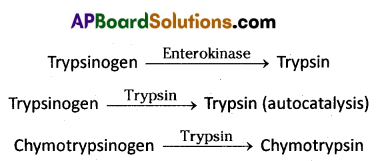
Proteins, proteoses and peptones (partly hydrolysed proteins) in the chyme, reaching the intestine are acted upon by the proteolytic enzymes of the pancreatic juice and intestinal juice as shown below :

Thus the end products of digestion of proteins namely amino acids are formed in the small intestine.
ii) Digestion of fats :
Bile salts of the bile help in the emulsification of fats i.e., break down of fats into very small micelles. Bile also activates lipases of pancreatic juice (steapsin)and intestinal lipases. These lipases act on emulsified fats and convert them into fatty acids and glycerols.
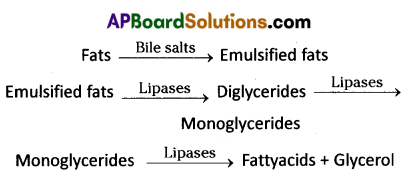
iii) Digestion of Carbohydrates :
Carbohydrates in the chyme are hydrolysed by the pancreatic amylase into disaccharides. Intestinal disaccharidases act on thet ‘disaccharides’ and convert them into monosaccharides.
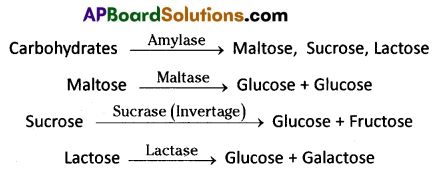
iv) Digestion of nucleic acids :
Nucleases (DNAase, RNAase) of the pancreatic juice act on the nucleic acids to form nucleotides and nucleosides. Nucleotidases and nucleosidases of the intestinal juice convert the nucleotides and nucleosides into pentose sugars and nitrogen bases.

![]()
Question 20.
Give a brief account of the structure and functions of the brain of man.
Answer:
Brain (‘the living super computer’): It is the site of information processing and control. It is protected in the cranial cavity and covered by three connective tissue membranes called ‘cranial meninges’ namely, dura mater, arachnoid mater and pia matter. Dura mater is the outer most, thick, double layered membrane which lines the inner surface of the cranial cavity. Arachnoid mater is a thin, webby middle membrane covering the brain. It is separated from the dura mater by a narrow subdural space. Pia matter is a thin, innermost meninx which closely adheres to the brain. Pia mater is separated from the arachnoid membrane by the subarachnoid space. The brain can be divided into three major parts called i) Forebrain,
ii) Midbrain and
iii) Hindbrain.
I) Forebrain (Prosencephalon) The forebrain consists of
i) Olfactory bulb,
ii) Cerebrum and
iii) Diencephalon.
i) Olfactory Bulb : Olfactory bulbs receive impulses pertaining to smell from the olfactory epithelium.
ii) Cerebrum : Cerebrum forms the major part of the brain and is longitudinally divided into the left and the right cerebral hemispheres by a deep cleft called ‘longitudinal fissure’. The two hemispheres are internally connected by a transverse, wide and flat bundle of myelinated fibres beneath the cortex, called ‘corpus callosum’ (colossal commissure). It brings ‘coordination’ between the right and left sides of the cerebral hemispheres. The surface of the cerebrum is composed of grey matter and is called ‘cerebral cortex’. The neuronal cell bodies are concentrated int he cerebral cortex.
The surrace of the cerebral cortex shows many convolutions or folds and grooves. The folds are called gyri (singular: gyrus), the deepest and shallower grooves between the folds are called fissures and sulci, respectively. Gyri and sulci increase the surface area of the cerebral cortex (which is an indication of the higher level of evolution of the human being).
Cerebral cortex has three functional areas called a) sensory areas, that receive and interpret the sensory impulses b) motor . areas. Which control voluntary muscular movements c) association areas, which are neither clearly sensory nor motor in function and they deal with more complex ‘integrative functions’ such as memory and communications. The cerebral medulla consists of mostly myelinated axons (white matter). Each cerebral hemisphere of the cerebrum is divided into four lobes namely frotnal, parietal, temporal and occipital lobes.
iii) Diencephalon (Thalamencephalon): The main parts of the diencephalon are the epithalamus, thalamus and hypothalamus.
i) Epithalamus : It is the roof of the diencephalon. It is a non – nervous part which is fused with the pia mater to form the anterior choroid plexus. Just behind the anterior choroid plexus, the epithelium of the epithalamus forms a pineal stalk, which ends in a rounded structure called pineal body.
ii) Thalamus : It lies superior to the mid brain. It is the major coordinating centre for sensory and motor signalling.
iii) Hypothalamus (the thermostat of the body) : It lies at the base of the thalamus. The hypothalamus forms a funnel – shaped downward extension called ‘infundibulum’, connecting the hypothalamus with the pituitary gland. It also contains several groups of neurosecretory cells, which secrete hormones called hypothalamic hormones. Hypothalamus controls and integrates the activities of the autonomous nervous system (ANS) and it has osmoregulatory, thermoregulatory, thirst, feeding (hunger) and satiety centres.
I) Limbic system : The inner parts of the cerebral hemispheres and a group of associated deep structures like amygdala or amygdale, hippocampus etc., form the limbic system. The limbic system along with hypothalamus is involved in the regulation of sexual behaviour and expression of emotional reactions.
II) Midbrain (Mesencephalon) : The midbrain is located between the thalamus / hypothalamus of the forebrain and the pons Varolii of the hindbrain. The ventral portion of the midbrain consists of a pair of longitudinal bands of nervous tissue called cerebral peduncles or crura cerebri (sing : crus cerebrum) (which connect the cerebral hemispheres with the pons). The dorsal portion of the midbrain consists of four rounded lobes called copora quadrigemina (Four optic lobes). The two larger anterior optic lobes are called superior colliculi and the smaller posterior lobes are called inferior colliculi. The superior colliculi and the inferior colliculi are concerned with visual and auditory functions, respectively.
III) Hindbrain (Rhombencephalon) : The hind brain comprises cerebellum, pons Varolii and medulla oblongata.
Cerebellum (‘the little brain’) : It is the second largest part of the brain. It consists of two cerebellar hemispheres and a central vermis. Each cerebellar hemisphere consists of three lobes namely anterior, posterior and floccular lobes. It has a branching tree – like core of white mater called arbor vitae (the tree of life) surrounded by a sheath of grey matter (cerebellar cortex).
Pons Varolii: It lies front of the cerebellum below the mid brain and above the medulla oblongata. It consists of nerve fibres which form a bridge between the two cerebellar hemispheres. It is a relay station between the cerebellum, spinal cord and the rest of the brain. Pons has the pneumotaxic centre (involved in the control of the respiratory muscles as it regulates the amount of air a person can take in, each time).
Medulla oblongata: It is the posterior most part of the brain. It extends from the pons Varolii above and continuous with the spinal cord below. It has a very thin, vascular folded structure called posterior choroid plexus. Medulla includes cardiovascular and respiratory centers, the centers for swallowing, vomiting, coughing, sneezing and hiccupping. The midbrain, pons and the medulla oblongata are together referred to as the ‘brain stem’. The medulla oblongata passes out of the cranium through the foramen magnum and joins the spinal cord.
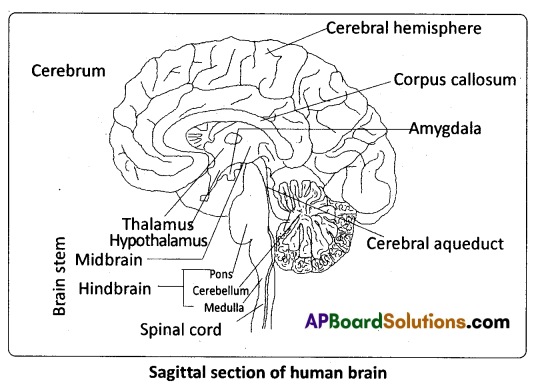
Human brain consists of four ventricles. The first and second ventricles (lateral ventricles or paracoels) are present in the right and left cerebral hemispheres respectively. The third ventricle (diocoel) occurs in the diencephalon. The two paracoels are connected to the median diocoel individually by the two ‘foramina of Monro’ (interventricular foramina). The fourth ventricle (myelocoel) is present in the medulla. The myelocoel and the diocoel are connected by a narrow canal called iter or aqueduct of Sylvius / cerebral aqueduct. The metacoel is continuous with the central canal of the spinal cord.
The ventricles of the brain, and the subarachnoid space are filled with Cerebro – spinal fluid (CSF). CSF is an alkaline, colourless fluid which is filtered from the choroid plexuses into the ventricles of the brain.
![]()
Question 21.
What is criss – cross inheritance ? Explain the inheritance of one sex linked recessive character in human beings.
Answer:
The crisscross pattern of inheritance (skip generation inheritance) is one in which a gene responsible for the sex linked recessive character is transmitted from a male parent.to a male grand child through a carrier female of the first generation. Colour blindness is the best example for criss – cross inheritance in human being.
Colour blindness : It is a sex-linked recessive disorder. Retina of the eye in man contains the cells sensitive to red and green colours. This phenotypic trait is genetically controlled. Its alleles are located on the X – chromosome. When a woman with normal vision (homozygous) marries a colour – blind man, all the sons and daughters are normal, but daughters are carriers (heterozygous). If a carrier woman marries a man with normal vision, all the daughters and half of the sons have normal vision and another half of sons are colour – blind. Colour – blind trait is inherited from a male parent to his grand sons through carrier daughter, which is an example of crisscross pattern of inheritance.
Haemophilia : Haemophilia A is recessive X – linked genetic disorder involving lack of the functional clotting Factor-VIII and represents 80% of haemophilia cases. Haemophilia B is also a recessive X – linked genetic disorder involving lack of the functional clotting Factor IX. When a person with hemophilia is injured, bleeding is prolonged because a firm clot is slow to form. Haemophilia follows the characteristic crisscross pattern of inheritance like that of colour – blindness.
Duchenne Muscular dystrophy: Duchenne muscular dystrophy (DMD) is a recessive X – linked form of muscular dystrophy, affecting around 1 in 3,600 boys. The disease is characterized by a progressive weakening of the muscles and loss of coordination. Affected individuals rarely live past their early 20s. The disorder is caused by a mutation in the dystrophin gene (the largest known gene in humans) located on the X – chromosome, which codes for the protein dystrophin, an important structural component within muscle tissue (connects sarcoiemma and the outer most
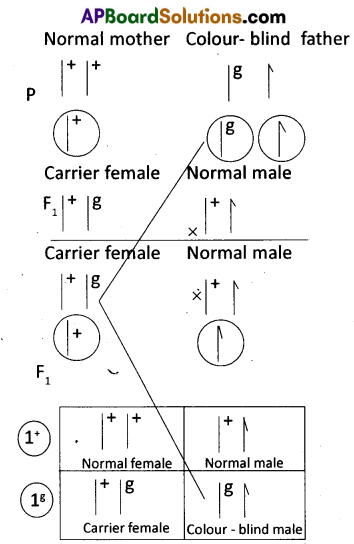
X – linked recessive inheritance Colour blindness
layer of muscle filaments and supports muscle fiber strength). If the mother is known to be a carrier of this gene, about half of her male children are expected to be affected. All female children born to a carrier mother are expected to be normal, since the possibility of their being homozygous for this sex – linked recessive gene is virtually non – existent.